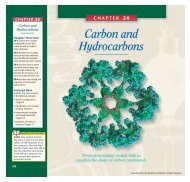Create successful ePaper yourself
Turn your PDF publications into a flip-book with our unique Google optimized e-Paper software.
Chapter 9<br />
Laboratory Exercise<br />
NOTE<br />
Materials Preparation is given on<br />
pp. 316A–316B. Blank data table<br />
and sample data table are on the<br />
One-Stop Planner CD-ROM. All<br />
calculations are performed using<br />
sample data.<br />
Planning<br />
Recommended time:<br />
1 lab period<br />
Classroom organization:<br />
This lab may be performed by<br />
students alone or in pairs.<br />
The CBL and sensors procedure<br />
and the Boyle’s law apparatus<br />
may be used in the same<br />
class.<br />
Safety warnings: This is a<br />
low-risk laboratory experiment.<br />
Remind students to follow<br />
all standard laboratory<br />
rules and procedures.<br />
350<br />
OBJECTIVES<br />
•Measure the volume and<br />
pressure of a gas at constant<br />
temperature.<br />
•Explore the relationships<br />
between the volume and<br />
pressure of a gas.<br />
MATERIALS LIST<br />
✔ Check list for appropriate<br />
procedure.<br />
PROCEDURE<br />
CBL AND SENSORS<br />
✔ CBL<br />
✔ graphing calculator <strong>with</strong> link<br />
cable<br />
✔ CBL pressure sensor <strong>with</strong><br />
CBL-DIN adapter and syringe<br />
✔ airline tubing (10 cm)<br />
BOYLE’S LAW APPARATUS<br />
✔ Boyle’s law apparatus<br />
✔ set of five 1 kg masses<br />
350<br />
Chapter 9<br />
CHAPTER 9<br />
Laboratory Exercise<br />
BOYLE’S LAW<br />
The ideal gas law states the relationship between the temperature, pressure,<br />
and volume of a confined ideal gas. At room temperature and atmospheric<br />
pressure, air behaves nearly like an ideal gas. In this lab, you will hold the<br />
temperature constant and explore the relationship between the volume and<br />
pressure of a fixed amount of air at a constant temperature. Because the air<br />
will be contained in an airtight syringe, the quantity of gas will be constant<br />
throughout the experiment.<br />
You will perform this experiment using either a CBL <strong>with</strong> pressure sensor<br />
or the Boyle’s law apparatus.<br />
• CBL and sensors You will use the pressure sensor to measure the pressure<br />
of the air at different volumes, starting <strong>with</strong> an initial volume of 10 cm 3<br />
and decreasing by 1 cm 3 increments. You will graph your data and analyze<br />
the graphs to find the relationship between pressure and volume for a gas.<br />
• Boyle’s law apparatus You will increase the pressure on a fixed quantity<br />
of air in a syringe by adding weight to the end of the plunger. As the<br />
pressure is increased, you will measure the change in volume using the<br />
markings on the syringe. You will graph your data and analyze the<br />
graphs to find the relationship between pressure and volume for a gas.<br />
SAFETY<br />
• Tie back long hair, secure loose clothing, and remove loose jewelry to<br />
prevent their getting caught in moving or rotating parts.<br />
• Wear eye protection. Contents under pressure may become projectiles<br />
and cause serious injury.<br />
PREPARATION<br />
1. Determine whether you will be using the CBL and sensors procedure or<br />
the Boyle’s law apparatus. Read the entire lab for the appropriate procedure,<br />
and plan what steps you will take.<br />
Boyle’s law apparatus procedure begins on page 352.<br />
Copyright © by Holt, Rinehart and Winston. All rights reserved.
















